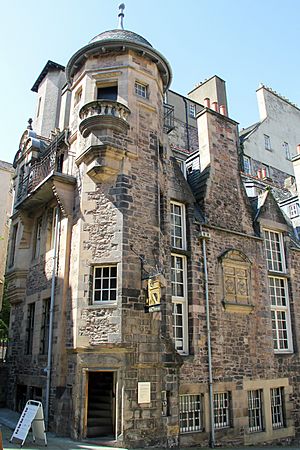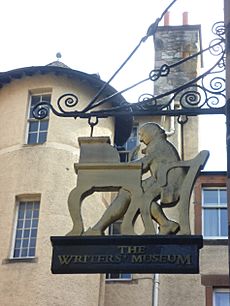Writers' Museum facts for kids

The Writers’ Museum is a special place in Edinburgh, Scotland. It's found in a historic building called Lady Stair’s House on the Royal Mile. This museum celebrates the lives and works of three very famous Scottish writers: Robert Burns, Walter Scott, and Robert Louis Stevenson.
The museum is managed by the City of Edinburgh Council. Inside, you can see many interesting things like portraits, copies of their books, and even personal items that belonged to these writers. Right next to the museum, there's a place called Makars' Court. This area is becoming a national monument to Scotland's literature.
Contents
Exploring the Writers' Museum
Robert Burns: Scotland's National Poet
Robert Burns is one of Scotland's most loved poets. The museum has several items that tell his story.
Burns Club Supper Invitation
You can see an invitation card from a Scottish Burns Club's Annual Supper. These suppers are held every year to celebrate Burns's birthday. The invitation shows what people would eat and who would give speeches at the event. It's a fun way to see how people honor his memory.
Listening to Burns's Words
There's also a special soundtrack playing in the museum. It features parts of letters and poems written by Robert Burns. This lets you hear his actual words and feel closer to his writing.
Walter Scott: The Storyteller
Sir Walter Scott was a very important writer known for his historical novels and poems. The museum has some unique items from his life.
Scott's Chess Set
One interesting item is a chessboard and chess pieces that once belonged to Sir Walter Scott. Even though he owned them, Scott wasn't very good at chess! He believed that learning new languages was a better use of his time than playing games. He once said, "Surely, chess playing is a sad waste of brains."
Special Slippers for Scott
You can also see a pair of slippers that were given to Scott as a gift in 1830. They were made from pink and blue wool and lined with silk. A lady named Louisa Cadogan sent them to him because she noticed his old slippers looked uncomfortable. She even wrote a letter explaining that the pattern on the new slippers was inspired by a design from the 15th century!
Scott's Inkstand
The museum displays an inkstand that belonged to Scott. He sometimes visited his legal assistant, William Carmichael, in the evenings. During these visits, Carmichael would play the fiddle, sometimes even helping Scott find tunes for his new poems.
The Ballantyne Press
A very special item is a hand-press believed to have been used to print Scott's famous novel, Waverley. This press was owned by James Ballantyne, who printed many of Scott's books. The success of these books helped Ballantyne's printing business grow. You can even hear a recording of a conversation between a chief printer and his young helper, giving you a peek into how books were made long ago.
Robert Louis Stevenson: The Adventurer
Robert Louis Stevenson wrote many famous stories, including Strange Case of Dr Jekyll and Mr Hyde and Treasure Island. The museum shows items from his adventurous life.
Books from His Travels
Stevenson loved to travel. The museum has a copy of The Bible in Spain by George Borrow, which Stevenson took with him on his famous trip called "Travels with a Donkey". He always carried many books on his journeys.
Art Inspired by His Journeys
There's also an illustration by Walter Crane that was inspired by Stevenson's "Travels with a Donkey." It shows a scene from the book where Stevenson describes looking at the sky, from reddish-grey to glossy blue-black with stars.
'Moral Emblems'
You can see a collection of stories and poems called 'Moral Emblems'. This book includes a story called "The Pirate and the Apothecary." In this tale, a respected chemist turns out to be a bit of a fake, while the pirate becomes the hero! It's a fun story that makes you think about who is truly good or bad.
The "10 Street Scene" Sculpture
A unique paper sculpture called "10 Street Scene" is also on display. This artwork was left anonymously at several literary places in Edinburgh. It shows support for "libraries, books, words, and ideas." It also shows admiration for writers like Ian Rankin and Robert Louis Stevenson. One side of the sculpture uses covers from Rankin's book Hide and Seek. Another part shows a scene from Stevenson's Strange Case of Dr Jekyll and Mr Hyde, where Edward Hyde attacks a woman.
Images for kids
See also
External links
- Official website: http://www.edinburghmuseums.org.uk/Venues/The-Writers--Museum








